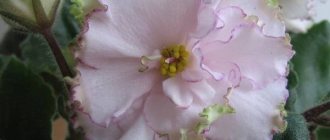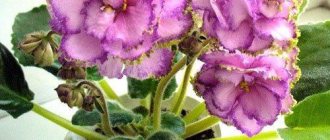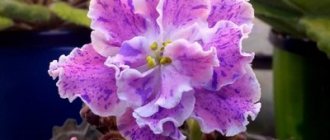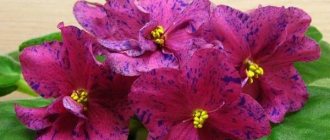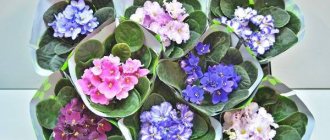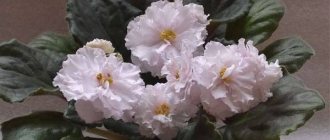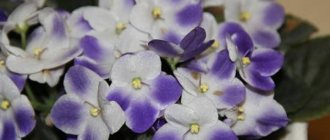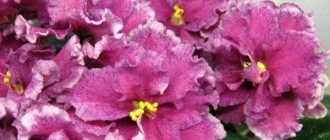I am the keeper of B.M. violet varieties. and T.N. Makuni.
I started collecting a collection of varieties of their selection a year and a half ago. Since the collection period is short and they are mainly grown from cuttings, the plants in the collection are in different forms - some are already blooming, and some are still children and even cuttings.
It is believed that Makuni created more than 400 varieties, but the author's catalog does not exist. Find out about the varieties B.M. And T.N. Makuni can be found, for example, on this website: https://senpolii-odessa.ucoz.ua/forum/62-….
Today my collection contains 133 Makuni varieties. Therefore, I turn to the help of collectors - please share those varieties that I don’t have!
I can buy, I can exchange for the varieties I have. All year round - meeting in Moscow, in the summer - additionally by Russian Post.
A small gallery of Makuni varieties
Memories of the Master (meeting with B.M. Makuni)
We sincerely congratulate everyone on Violet Day!
Why September 29? – this day was chosen in honor of the birthday of the Master of domestic selection, Boris Mikhailovich Makuni. And today we want to give you an article-memory about him...
Many people often ask us the question - where did our passion for violets begin? And I would answer - from Makuni.
When the first non-varietal violets appeared in our house, my husband gave me the book “Saintpaulia (Uzambara violets)” by Boris Mikhailovich Makuni. We didn’t even suspect that such beauty could exist in the world! Such a variety of colors, types, petals and leaves! I must say that in 2001 the first mentions of the Internet in our city were just beginning to appear, and the book - a real BOOK - became a whole discovery for us!
And since my husband believes that “the dream must be big,” the decision very quickly came to create my own collection of varietal violets! And only Boris Mikhailovich could help us with this. But how can you contact a person from a multimillion-dollar city, because there is no phone number in the book, and the address is not accurate? Fortunately, the surname “Makuni” is quite rare and the husband managed to contact its owner through the Moscow address office and make an appointment.
Without delaying a day, the three of us went - my husband, me and my son. The door was opened for us by an elderly, but tall, stately, very interesting man with an amazingly kind smile! He radiated cordiality and warmth! But of course, it was not only and not so much he who struck. His collection left an indelible mark on my memory! Now I understand that it was placed on only a few shelves, but at that moment it seemed surprisingly large and fabulously beautiful! No photographs from the book could compare with real blooming violets! We walked from shelf to shelf and listened with great interest to this extraordinary man, who shared with us his experience, observations, and growing secrets. With an inimitable sense of humor, he told stories about his favorites! At that time, his “Jolly Potassium Permanganate” - a violet with a very bright fuchsia-pink color and a very cheerful appearance! Yes, Boris Mikhailovich very aptly chose names for his “children”! For some - by color. For others - by character! For example, that time he complained to us about a variety that did not want to produce the right flowers and had already exhausted him. In his hearts, he called him “Blya-fly!” – this name was subsequently assigned to the variety. And how many beautiful, gentle and touching names! Snow-white “Tatiana’s Day”, heavenly “Solveig’s Song”, radiant “Winter Smiles”, mysterious “Magic”, extraordinary “Leshy”, sweet “Beloved Daughter”, the most touching and sad “In Memory of Tanya Makuni”...
He also showed his “pregnant” violets - that’s what he called rosettes with ovaries. Looking at them, we experienced a special feeling of anticipation for new varieties. After all, I really wanted to know what beauties await us in the future!
Boris Mikhailovich drew our attention to a variegated variety that appeared in his possession - at that time this was a rarity! Such a violet pleases not only during flowering, but all year round. Moreover, this variety, in his words, was not distinguished by abundant flowering. Maybe that's why I didn't remember its name.
Another joy of the owner is the paintings of his son Denis, which he showed us with pleasure and paternal pride. These were wonderful landscapes, painted in a classical style! Denis himself was also present at the meeting and willingly kept up the conversation.
In general, Boris Mikhailovich was surprised how we managed to contact him, and when the conversation turned to a rare surname, he told us his “pedigree.” It turns out that his Italian great-great-grandfather was captured during the Patriotic War of 1812 as part of the French army. He was left as a worker in some rich Russian family. And the owner’s daughter, as in a classic novel, fell in love with a handsome, ardent foreigner! From them came the Makuni clan in Russia.
During B.M.’s story, I couldn’t take my eyes off the flower racks. Perhaps due to the fact that before that I had only encountered small blue “grandmother’s” violets, large double pink flowers attracted all my attention. At that moment, two seedlings of the “Miraculous” variety, as he called them, bloomed, and I liked them so much that I really wanted to buy one of them. But the wise owner advised me to take a third plant in buds, promising that it would be even more beautiful than these two. And his words turned out to be absolutely true - it really turned out to be simply wonderful!
Makuni’s collection included varieties not only of his own selection, but also many interesting foreign violets. We purchased about 70 varieties from him. And in 10 years, only two varieties were lost. By a strange coincidence, one of them is “Lovely Stranger”, the second is “Lovely Mother-in-Law”. All other varieties have been preserved from the author's collection, which I am very proud of!
I especially remember how the owners carefully and carefully packed the violets for us and signed the names on “branded” pieces of paper, with a figurine of a little fox carrying a flower. Now I really regret that I didn’t leave them as a souvenir, although I kept them for several years. Saying goodbye to an amazing man who, as it later turned out, radically changed our lives, we asked him to sign his book for us, which he had prudently taken with him. Now this book is kept in the family library as a very memorable and valuable family heirloom.
Author of the article: Galina Krutova
T. Makuni, B. Makuni “Saintpaulia and light”
Inexperienced flower growers, when caring for their violets, first of all pay attention to fertilizing, watering, and soil mixtures, but lighting, in their opinion, seems to go without saying and does not require much trouble. Flower growers often come to us with the question of what to do to make their pets feel good? When we find out the conditions of detention, we often give advice not to feed, not to change the soil mixture, but simply to move the plants to another place. Usually 3-4 weeks after this, the violets transform and bloom.
It is difficult to overestimate the importance of light in the life of any plant. It is in the light that the most important process occurs in its green parts - photosynthesis, as a result of which the leaf, like a kind of biochemical plant, creates complex organic substances from simple compounds - water and carbon dioxide - that are used to build new plant tissues.
Different crops, of course, need different illumination: for example, in their homeland, cacti grow in bright sun, while Saintpaulia grows under a canopy of trees and shrubs, in heavy shade. And in Saintpaulia culture they prefer diffused light; direct rays of the sun are contraindicated for them. We consider the optimal illumination to be the kind of illumination that occurs in the summer on cloudy, cloudy days. You can quite accurately determine the required degree of shading of a sunny window using a photo exposure meter. To do this, at noon in cloudy weather outside, the reading of the device is recorded.
(preferably away from buildings). Then the window in the room, illuminated by the sun, is shaded so that on the windowsill, at a distance of 20 cm from the glass, the exposure meter shows the same values as on the street.
The duration of illumination is also important. Since Saintpaulias live in equatorial latitudes, it should be approximately 12-14 hours a day.
The amount of light in various rooms depends not only on the orientation of the windows to the south or north, but also on the size of the window openings, their shading from the outside by trees, buildings, an upper floor balcony or loggia. Additional light can come from reflections from light-colored buildings. You also have to take into account the floor on which the apartment is located. And, of course, illumination varies greatly depending on the time of year. The gardener will have to gradually find the most suitable place for his plants during the growing process. We want to give some basic advice.
In mid-latitudes, shading is only necessary from March to October. If Saintpaulias are left unprotected in a sunny window in hot weather, they will soon show signs of depression. Light green leaves will gradually turn yellow, dark green leaves will even acquire a brown tint. They will become very dense, the petioles will become short, and the leaf blades will press against the edges of the pots. In the center of the rosette, the young leaves will begin to close tightly. The peduncles are so shortened that the flowers seem to be hidden under the leaves. Their color fades, they become smaller and quickly fade. Growth slows down or even stops altogether.
For shading, you can use fabric (tulle, gauze, muslin) in one or several layers. Translucent tracing paper or plastic film are suitable for this purpose. True, near the latter the air temperature rises noticeably, so it should be strengthened outside or between the frames. Some gardeners whiten glass with lime mortar.
Additional shading can be achieved by placing small-leaved ampelous plants on the window closer to the glass - tradescantia, columna, aeschynanthus.
If Saintpaulias with signs of exposure to excessive lighting are shaded, they will not immediately restore their previous appearance. Only young, newly developing leaves will acquire a normal green color. Old, yellowed ones will subsequently need to be removed, but only when new ones have developed properly.
If in mid-latitudes Saintpaulias are constantly located on the northern window, in winter, with short days, they experience a lack of light. Plants stop blooming, their petioles become elongated and become brittle, and their leaf blades enlarge. The leaves rise up, their tissue becomes loose. Having formed under such conditions, they will not change in the future even with optimal maintenance. Only young ones will acquire normal color and density.
Different varieties of Saintpaulia also need different illumination. Plants with dark green dense and highly pubescent leaves, with large star-shaped flowers and thin petals are placed on the windowsill in the second or even third row. In order for the rosette of leaves to develop evenly, the pots with Saintpaulias must be periodically turned in different directions in relation to the light.
In our apartment on the 9th floor, the windows face west. From the second half of February, the number of clear days increases noticeably; from two o'clock in the afternoon until the evening the windows are illuminated by the sun. For shading, we have to whiten the glass with lime mortar. In June-July this is no longer enough, and we strengthen the shade with two layers of tracing paper.
| 'Pharaoh' (breeders B. M. and T. N. Makuni). The flowers are large, wine-red, velvety-rich, star-shaped, simple and semi-double. The leaves are dark green, round, slightly pointed, with smooth edges, burgundy on the underside, on dark petioles. The rosette is regularly shaped, round and compact. Peduncles are stable, flowers rise above the leaves. Blooms abundantly in spring. Compared to other varieties it grows slowly. | 'Pomegranate Bracelet' (breeders B. M. and T. N. Makuni). The flowers are medium-sized, double, pale pink, with a contrasting cherry-wine edge around the edges of the petals. The leaves are dark green, elongated, slightly wavy, slightly toothed along the edges, burgundy on the underside, the central vein is lighter. Flowering is abundant and periodic. The socket is compact. The variety suffers from excessive fertilizing. |
T. MAKUNI, B. MAKUNI
Magazine "Floriculture" No. 4 1994
